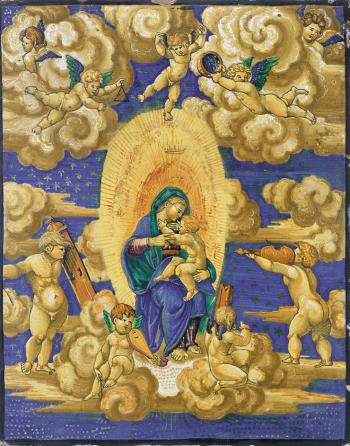Madonna and Child with Angelic Musicians
Palazzo Baldeschi Museum

Francesco Xanto Avelli da Rovigo e Mastro Giorgio Andreoli da Gubbio
majolica lustreware
1528-1532 ca
This rectangular plaque, attributed to Xanto, depicts the Madonna and Child surrounded by nine angelic musicians. The holy child is seated on the lap of a gracious blond matron whose cheeks are made rosy by the sun’s rays: her left hand supports him while the right appears to be making a distinct two-fingered gesture towards him. The Madonna wears a blue cape the reverse of which is a bright copper green; colours which feature frequently in the artist’s work. The figures are placed in a bright blue starry sky, composed of tight horizontal brushstrokes, in which a host of drifting clouds frame the scene.
The painting’s iconography was inspired by one of Marcantonio Raimondi’s engravings. Xanto’s composition features his habitual modifications to adapt the figures to his theme: seating the virgin, who stood in the original, and rotating the child’s posture anticlockwise to reveal the virgin’s belt.
This plaque can be traced to the early years of Xanto’s career, between 1528 and 1532, when the artist’s pieces weren’t always signed by his hand. However, he did often add an inscription on the reverse side of his work with an explanation of the subject matter followed by a flourish that has been deciphered as the letter “y” or “” which is why his oeuvre is referred to as the “ y / Series”.
Almost the handful of lustreware pieces that can be dated to 1528-1530 many that bear the lustred signature of Maestro Giorgi, are flanked by a polychrome description of the subject signed by Xanto. In view of the fact that this plaque bears no inscriptions it is not possible to determine its provenance. However, there are three alternative theories pertaining to this: It may have been executed in its entirety by Xanto in Maestro Giorgio’s Gubbio workshop; It may have been painted in Urbino and then sent to Gubbio for lustrework and sale; It may have been both painted and lustred in Urbino. The modest dimensions of the plaque suggest it could have been intended for domestic worship. It’s worth noting that this is not the only devotional plaque Xanto painted.